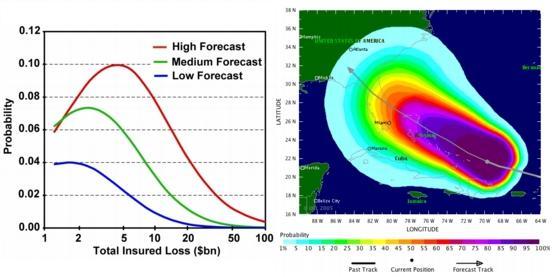The Tropical Storm Risk (TSR) venture developed
from the UK government-supported
TSUNAMI
initiative
project on seasonal tropical cyclone prediction
which ran from October 1998 to June 2000.
TSR uses cutting-edge science and technology to develop
innovative products to benefit risk awareness and
decision making in business, government and society.
Examples include:

- Application of seasonal hurricane forecasts in U.S. property catastrophe reinsurance. Through a breakthrough in forecasting US hurricane activity published in Nature, and in collaboration with the Bank Leu, TSR has provided the first direct demonstration of the business relevance of hurricane forecasts for selling and buying (re)insurance cover.
- Tropical Storm Tracker and its forecast wind probabilities and wind fields. TSR has developed the leading global tracker on the market. Tropical Storm Tracker won the British Insurance Award for London Market Innovation of the Year in 2004. The judges cited that the Tracker was "innovative, relevant and unquestionably an asset to the London market".
- Seasonal probabilistic forecasts of basin and landfalling tropical cyclone activity worldwide. TSR has developed innovative probabilistic models for predicting seasonal basin and seasonal landfalling tropical cyclone activity in the North Atlantic, NW Pacific and Australian regions. These forecasts are updated monthly and provide skilful outlooks for assessing the likelihood of upcoming damage and disruption.
- Tropical storm alert feeds. During 2004 Tropical Storm Risk introduced tropical storm alert feeds to Reuters AlertNet, the global humanitarian news portal, and to the United Nations World Food Programme. There were 865,000 page views of TSR sourced content at AlertNet between February and September 2004.
| US hurricane total insured loss contingent on the TSR 1st August forecast. The chance of a large total loss is clearly much higher in those years when the forecast is high. For example, a total hurricane insured loss of $10 bn is eight times more likely to occur when the forecast is high compared to when it is low. Clearly if extra reinsurance cover were purchased in the high forecast years a company's volatility in losses (or risk) would be reduced. (Figure taken from Saunders, Lloyd-Hughes and Hilti (2005)). | Probability (in percent) of experiencing 1-min sustained wind speeds of at least tropical storm strength (34kt or 39 mph) from hurricane Frances. The diagram refers to the 69 hours starting at 15:00 GMT on September 1, 2004 when Frances was located north of the Dominican Republic. Click on image for enlargement. |
